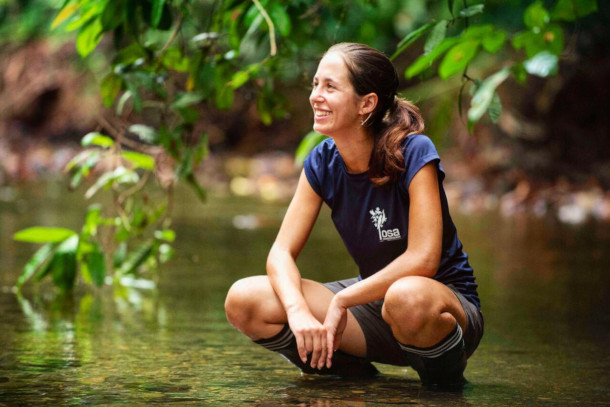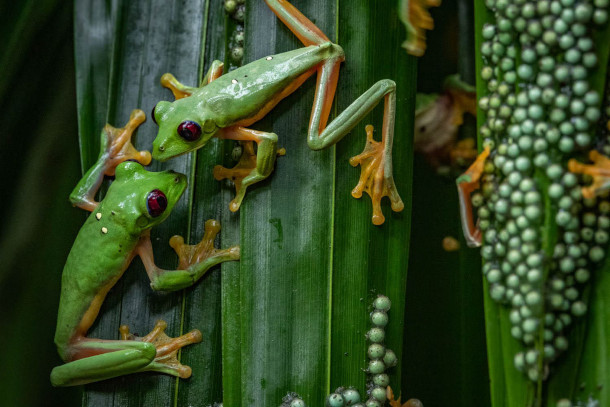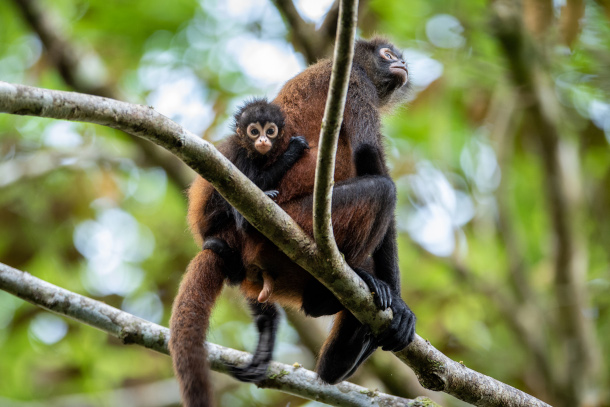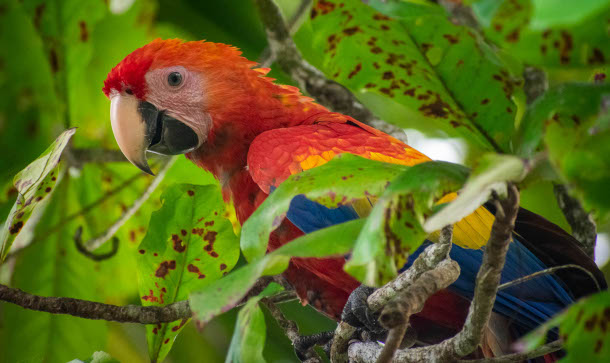Audio Postcard: Osa Peninsula in Costa Rica
Air Date: Week of May 28, 2021

Hilary Brumberg is the Lowlands Ridge to Reef Program Coordinator at Osa Conservation (Photo: Nina Cordero)
The Osa Peninsula, a remote area on Costa Rica’s southern border, harbors 2.5% of the entire planet's biodiversity in a vanishingly small fraction of Earth’s total surface area. Hilary Brumberg is a researcher with the NGO Osa Conservation and sent us this audio postcard.
Transcript
CURWOOD: Costa Rica is one of the most biodiverse nations on Earth. The Osa Peninsula, on the southern border, for instance, is a tiny fraction of the planet but home to roughly 2.5% of the planet's biodiversity. Hilary Brumberg is a researcher with the NGO Osa Conservation. She sent this audio postcard.

The Osa Peninsula is one of the most biodiverse places on Earth. It harbors 2.5% of the entire planet's biodiversity in less than a thousandth of a percent of its total surface area. (Photo: Lucy Kleiner)
BRUMBERG: My name is Hilary Brumberg, and I am the Lowlands Ridge to Reef Program Manager here at Osa Conservation in the Costa Rican rainforest. Right now, I'm standing in one of the restoration and rewilding plots here at Osa Conservation. And this project is really exciting for me because when I first arrived in Costa Rica, just four years ago, this whole area was abandoned cattle pasture. And then I worked closely with our team, mostly local conservationists and dedicated scientists, to reforest this land. And it's spectacular because just four years later, the trees are already a couple of stories tall and providing us with great shade, which is much appreciated on these hot days in Costa Rica.

All four of Costa Rica’s primate species are found in the Osa Peninsula, including the Central American Spider Monkeys pictured above. Others include the Mantled Howler, the White-Faced Capuchin, and the Central American Squirrel Monkey. (Photo: Lucy Kleiner)
I love working in ecological restoration because I feel like nature's little helper. I'm helping undo some of the damage that humans have caused on our ecosystems by reforesting, and attracting wildlife through rewilding techniques. Regrowing a rain forest is a very long and rewarding process. The very first step is that our team of botanists will go out in the rain forest and collect seeds from other trees. Sometimes this will even include having to climb trees in order to collect the fruits before the monkeys get to them. Then, we will germinate the seeds and grow them into little saplings. And we mostly focus on endemic, endangered, and rare trees in order to facilitate climate change resilience and to attract biodiversity.

The largest population of Scarlet Macaws in Costa Rica is in the Osa Peninsula. (Photo: Lucy Kleiner)
When the trees are big enough and ready to be planted, we will then work the local community to strategically identify locations to plant the trees. We mostly work in biological corridors that connect the national parks in the area, Corcovado and Piedras Blancas, and La Amistad International Peace Park. And we also mostly focus on reforesting rivers because that's where you can get more bang for your buck, or return on conservation investment in a lot of ways because not only are you protecting the forest, but you're also protecting the river water quality. And then the rivers will flow out into the Golfo Dulce or the ocean. And so that also protects marine and coastal ecosystems.
A community tree planting day in the Osa Peninsula. (Photo: Courtesy of Hilary Brumberg)
When living in the rainforest, there's a lot of opportunities for solitude. But there aren't a lot of opportunities for silence. Here, there's always a lot of life and a lot of sounds happening. So it can be anything from the howler monkeys waking you up at 4:30 in the morning, the dawn chorus of the birds, or frogs and insects chirping away at night, or even when the animals are being quiet you can hear the loud crashing waves onto the beaches of the Osa peninsula. And so I'm always incredibly grateful to be able to listen to these spectacular sounds. And when I call home, what can be really fun is that my friends and my family will get to hear in the background all of the sounds of the rainforest. And they're always like pointing out to me different bird calls that they hear or different frog sounds or how I'm down by the beach, they’ll get to hear the waves. That's a very special way to share what I'm living with my loved ones back home.
CURWOOD: Hilary Brumberg is a researcher with Osa Conservation in Costa Rica.
Links
Hilary Brumberg’s latest research on riparian forest buffers to conserve river water quality
National Geographic’s recent coverage of the Osa Peninsula
Video: Rewilding Forests and Communities, Osa Peninsula, Costa Rica
Living on Earth wants to hear from you!
Living on Earth
62 Calef Highway, Suite 212
Lee, NH 03861
Telephone: 617-287-4121
E-mail: comments@loe.org
Newsletter [Click here]
Donate to Living on Earth!
Living on Earth is an independent media program and relies entirely on contributions from listeners and institutions supporting public service. Please donate now to preserve an independent environmental voice.
NewsletterLiving on Earth offers a weekly delivery of the show's rundown to your mailbox. Sign up for our newsletter today!
 Sailors For The Sea: Be the change you want to sea.
Sailors For The Sea: Be the change you want to sea.
 The Grantham Foundation for the Protection of the Environment: Committed to protecting and improving the health of the global environment.
The Grantham Foundation for the Protection of the Environment: Committed to protecting and improving the health of the global environment.
 Contribute to Living on Earth and receive, as our gift to you, an archival print of one of Mark Seth Lender's extraordinary wildlife photographs. Follow the link to see Mark's current collection of photographs.
Contribute to Living on Earth and receive, as our gift to you, an archival print of one of Mark Seth Lender's extraordinary wildlife photographs. Follow the link to see Mark's current collection of photographs.
 Buy a signed copy of Mark Seth Lender's book Smeagull the Seagull & support Living on Earth
Buy a signed copy of Mark Seth Lender's book Smeagull the Seagull & support Living on Earth

